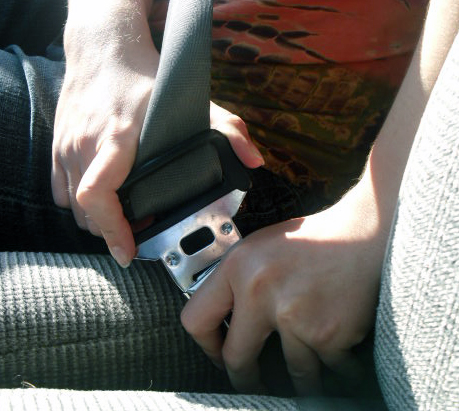Click it or ticket for those who do not fasten their seat belts

This archived article was written by: Mara Wimmer
Mariah is driving down the road coming home after the weekend. It has been a long drive and her seat belt begins chafing. Mariah takes it off and BOOM! She miscalculated a turn and her car is now on the side of the road. The front bumper is mangled and hugging a large tree. There was nothing holding her in her seat and the force of the crash flung her forward, through the windshield into the tree. Mariah is lodged in the branches of the tree, having completely missed the air bag.
Mariah could still be in her car if she had been wearing the built-in safety feature: her seat belt. Seat belts are not installed in cars as an inconvenience, they are there to save lives. According to the Center for Disease Control (CDC), motor vehicle accidents are the leading cause of death for people under the age 30.
“We are in a hurry trying to get places, which is why we get into crashes. I am not surprised that it is the cause,” Mykenze Gross, a freshman, said.
Wearing a seat belt correctly gives passengers a 45-percent better chance of survival. Since 1975, seat belts have saved approximately 255,000 lives. The only way seat belts can save lives is if people wear them.
Wearing a seat belt is not only about the fatal crashes, it is also about minimizing damage in the smaller ones. In smaller collisions, it is common for people to suffer from head injuries from hitting the steering wheel, the dashboard or even the back of the seat in front of them. By adding the extra restraint of a seat belt, the collision is not quite as forceful.
A freshman at Utah State University Eastern has seen the effectiveness of seat belts. Alejandra Gonzalez’s mother was in an accident where another vehicle rear ended her vehicle and pushed her car into the vehicle in front of her.
“The seat belt kept her from hitting her head on the steering wheel and instead of head trauma, she only suffered from back pain,” Gonzalez said.
The younger individuals, those who are getting their driver’s licences, are inundated with the staggering statistics to stay safe. Videos, billboards, radio ads and talking to people are all ways people are telling others to fasten seat belts to stay safe. As a result of the constant reminders, it is common to develop putting a seat belt on as a habit. When asked why they wear seat belts, many people acknowledge it as a habit. Even if it is a habit, putting on a seat belt increases the chances of survival and reduces the chances for more severe injury.
“I always put it on while I am driving, it is more of a habit,” Gross said.
Young adults and teen drivers have become the “seat belt” generation. From the first time getting in a car, coming home from the hospital as a baby, they have been wearing seat belts. Seat belts have been an integral part of their lives and it is common place to be buckled while in a vehicle.
Many organizations have been starting to encourage the use of seat belts in all vehicles. Some are so common they are easily recognized logos or sayings such as Zero Fatalities, U.S. Department of Transportation, “Click it or ticket,” and many others. With so many constant reminders out there companies are hoping drivers and passengers have less reason to forget their seat belts.
Seat belts save lives. The only way they can save lives is if people use them and use them correctly. More and more people are wearing them and more and more lives are saved. Whether it is a habit or a conscience thought, putting on a seat belt can change the outcome of the day. Stay safe and stay buckled.




